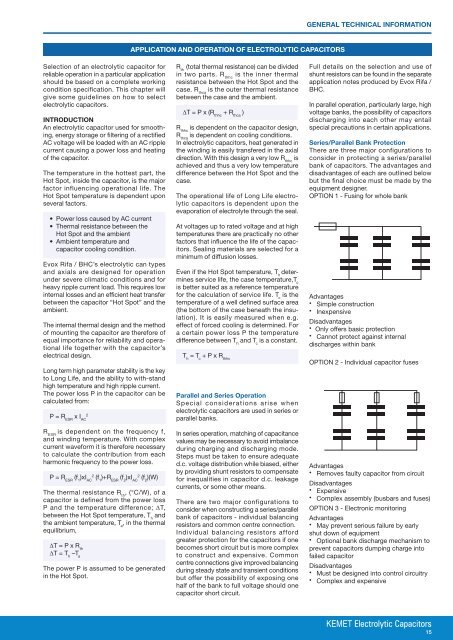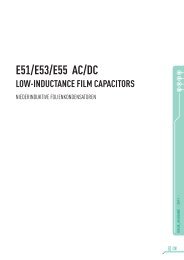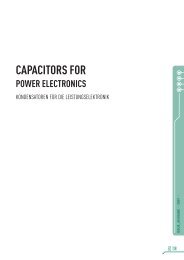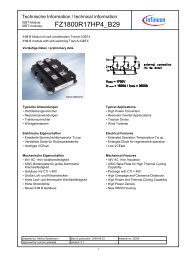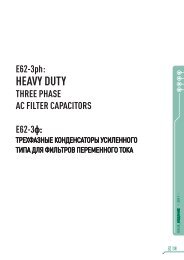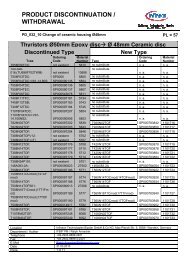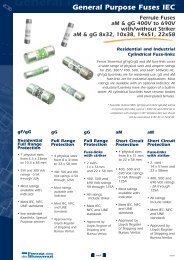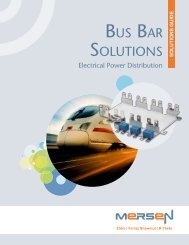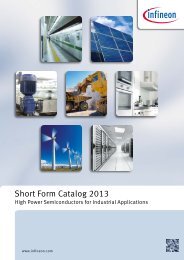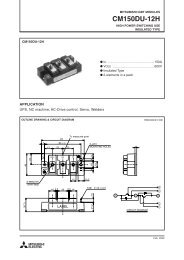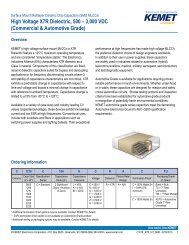Quality Policy
Quality Policy
Quality Policy
- No tags were found...
You also want an ePaper? Increase the reach of your titles
YUMPU automatically turns print PDFs into web optimized ePapers that Google loves.
General Technical InformationApplication and operation of electrolytic capacitorsSelection of an electrolytic capacitor forreliable operation in a particular applicationshould be based on a complete workingcondition specification. This chapter willgive some guidelines on how to selectelectrolytic capacitors.IntroductionAn electrolytic capacitor used for smoothing,energy storage or filtering of a rectifiedAC voltage will be loaded with an AC ripplecurrent causing a power loss and heatingof the capacitor.The temperature in the hottest part, theHot Spot, inside the capacitor, is the majorfactor influencing operational life. TheHot Spot temperature is dependent uponseveral factors.• Power loss caused by AC current• Thermal resistance between theHot Spot and the ambient• Ambient temperature andcapacitor cooling condition.Evox Rifa / BHC’s electrolytic can typesand axials are designed for operationunder severe climatic conditions and forheavy ripple current load. This requires lowinternal losses and an efficient heat transferbetween the capacitor “Hot Spot” and theambient.The internal thermal design and the methodof mounting the capacitor are therefore ofequal importance for reliability and operationallife together with the capacitor’selectrical design.Long term high parameter stability is the keyto Long Life, and the ability to with-standhigh temperature and high ripple current.The power loss P in the capacitor can becalculated from:P = R ESRx I AC2R ESRis dependent on the frequency f,and winding temperature. With complexcurrent waveform it is therefore necessaryto calculate the contribution from eachharmonic frequency to the power loss.P = R ESR(f 1)xI AC2(f 1)+R ESR(f 2)xI AC2(f 2)(W)The thermal resistance R th, (°C/W), of acapacitor is defined from the power lossP and the temperature difference; ΔT,between the Hot Spot temperature, T handthe ambient temperature, T a, in the thermalequilibrium,ΔT = P x R thΔT = T h–T aThe power P is assumed to be generatedin the Hot Spot.R th(total thermal resistance) can be dividedin two parts. R thhcis the inner thermalresistance between the Hot Spot and thecase. R thcais the outer thermal resistancebetween the case and the ambient.ΔT = P x (R thhc+ R thca)R thhcis dependent on the capacitor design,R thcais dependent on cooling conditions.In electrolytic capacitors, heat generated inthe winding is easily transfered in the axialdirection. With this design a very low R thhcisachieved and thus a very low temperaturedifference between the Hot Spot and thecase.The operational life of Long Life electrolyticcapacitors is dependent upon theevaporation of electrolyte through the seal.At voltages up to rated voltage and at hightemperatures there are practically no otherfactors that influence the life of the capacitors.Sealing materials are selected for aminimum of diffusion losses.Even if the Hot Spot temperature, T hdeterminesservice life, the case temperature,T cis better suited as a reference temperaturefor the calculation of service life. T cis thetemperature of a well defined surface area(the bottom of the case beneath the insulation).It is easily measured when e.g.effect of forced cooling is determined. Fora certain power loss P the temperaturedifference between T hand T cis a constant.T h= T c+ P x R thhcParallel and Series OperationSpecial considerations arise whenelectrolytic capacitors are used in series orparallel banks.In series operation, matching of capacitancevalues may be necessary to avoid imbalanceduring charging and discharging mode.Steps must be taken to ensure adequated.c. voltage distribution while biased, eitherby providing shunt resistors to compensatefor inequalities in capacitor d.c. leakagecurrents, or some other means.There are two major configurations toconsider when constructing a series/parallelbank of capacitors - individual balancingresistors and common centre connection.Individual balancing resistors affordgreater protection for the capacitors if onebecomes short circuit but is more complexto construct and expensive. Commoncentre connections give improved balancingduring steady state and transient conditionsbut offer the possibility of exposing onehalf of the bank to full voltage should onecapacitor short circuit.Full details on the selection and use ofshunt resistors can be found in the separateapplication notes produced by Evox Rifa /BHC.In parallel operation, particularly large, highvoltage banks, the possibility of capacitorsdischarging into each other may entailspecial precautions in certain applications.Series/Parallel Bank ProtectionThere are three major configurations toconsider in protecting a series/parallelbank of capacitors. The advantages anddisadvantages of each are outlined belowbut the final choice must be made by theequipment designer.OPTION 1 - Fusing for whole bankAdvantages• Simple construction• InexpensiveDisadvantages• Only offers basic protection• Cannot protect against internaldischarges within bankOPTION 2 - Individual capacitor fusesAdvantages• Removes faulty capacitor from circuitDisadvantages• Expensive• Complex assembly (busbars and fuses)OPTION 3 - Electronic monitoringAdvantages• May prevent serious failure by earlyshut down of equipment• Optional bank discharge mechanism toprevent capacitors dumping charge intofailed capacitorDisadvantages• Must be designed into control circuitry• Complex and expensiveKEMET Electrolytic Capacitors15


